#Nagabakama
Text

Edo period types of hakama pants, fantastic chart by Edo-lover Nadeshico Rin. You can see here from left to right, top to bottom:
Fundomi hakama 踏込袴 - pants with a narrow bottom hem, a type of nobakama (see below)
Tattsuke hakama 裁付袴 - pants tight below the knee, sometimes refered as "ninja pants" (= Iga hakama). Those were worn by many, from samurai to servants and craftmen.
Umanoribakama 馬乗袴 - lit. "riding pants", wide hakama with high gusset split legs for confortable horse riding.
Nagabakama 長袴 - formal trailing hakama worn by samurai from late Muromachi era.
Andonbakama - skirt-like hakama worn by Meiji period female teachers and students (hence why it's sometimes called onna bakama). A boy version appeared after mid-Meiji.
Yamabakama 山袴 - daily-life work pants with narrow legs and sometimes a gathered bottom hem. Name greatly varies depending on areas and time. A direct descendant of this style are women's monpe もんぺ.
Nobakama 野袴 - shorter hakama with black velvet hem, worn by travelling samurai. It was also part of firefighters' gear.
Hirabakama 平袴 - the "classic" ankle lenght men hakama pants, with a low gusset which means it looks nice when sitting (tailoring is hence different from the umanori, see above). Also called hanbakama 半袴, those were longer than the ancient kobakama 小袴 and shorter than formal trailing nagabakama (see above).
#japan#historical fashion#fashion history#ressources#hakama#hakama pants#references#edo period#edo era#nadeshico rin#Fundomi hakama#Tattsuke hakama#Iga hakama#Umanoribakama#Nagabakama#Andonbakama#Yamabakama#monpe#Nobakama#Hirabakama#hanbakama#kobakama#japanese pants#着物#袴
1K notes
·
View notes
Text
that thing where samurai had to wear nagabakama (big trailing kamishimo) to stop them from hopping up and killing each other is so funny, mr japan why are you so aggro !!! born to attack forced to sit still and be polite
38 notes
·
View notes
Text

Kokushibo Redesign
Concept art and drabbles under the cut. Warning for spoilers!
I wanted to draw him in a formal style that was popular amongst samurai of the Sengoku Period. The kataginu is meant to be tucked into the nagabakama but I wanted a more casual look I decided to give him nagabakama instead of hakama because I like the idea of him moving around slowly. Also, if he grows, they will look like hakama!

I also gave him a wakizashi (short sword). It was typical for samurai to have both a katana and a wakizashi. That said, I think Kokushibo would come to resent the sword after his transformation. It is a symbol of his inadequacy compared to Yoriichi as well as a reminder of how he was fated to die young.
So, I have this idea that he would delegate his blades to extensions of himself! He could separate himself into three parts, one for each pair of eyes. His upper pair representing yang energy, the lower pair representing yin energy. I’m a big fan of hinamatsuri dolls so I designed the counterparts to be reminiscent of them. I think it would be an interesting comparison to Yoriichi Type 0. I had an idea that they might actually be small dolls that Kokushibo carved himself, then he just transfers flesh to them as he does his sword.
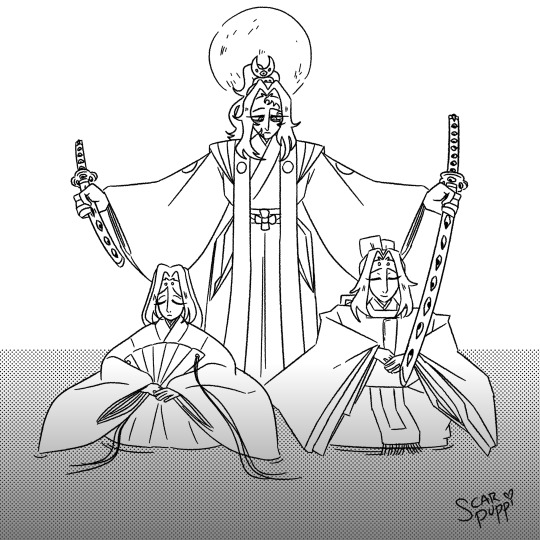
I wanted to play with different shapes for the dolls and make them distinctly different. Yang energy is connected to masculinity, positivity, and sharp angles. Yin energy is connected to femininity, negativity, and curved shapes. I gave them small hands to make them appear more delicate. But they’re anything but!

#theo's trade#demon slayer#kny fanart#kimetsu no yaiba#kokushibo#character redesign#there's more to this but this is already so long#expect more info in the coming days
174 notes
·
View notes
Text
Onryō - Himiko - Character Concept
An Onryō is a Japanese yōkai—a vengeful spirit born from a woman's intense emotions upon death. Typically, they stem from a history of abuse, unrequited love, or similar distressing experiences. We delve into the story of one such Onryō, formerly named Himiko. Her life was marred by tragedy, sold into marriage due to her family's financial constraints. Her husband, abusive and cruel, tragically ended her life during one drunken episode.

A selection of shapes.
Upon awakening as an Onryō, Himiko found herself engulfed in a frenzy of vengeance. Her quest led her to relentlessly slay men resembling her deceased husband, sparing only women and children. However, a chance encounter with a wandering monk altered her path. Though still a demon, she adopted a more human-like form and a new purpose—to seek redemption and mend the havoc she wreaked.
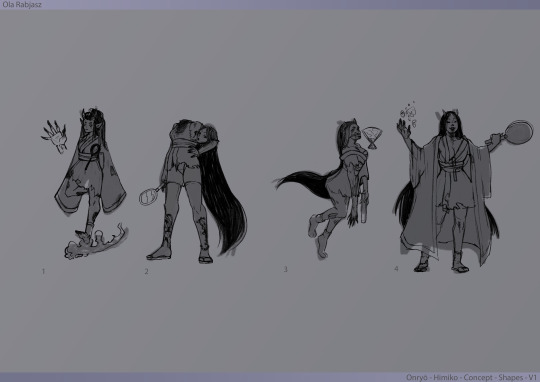
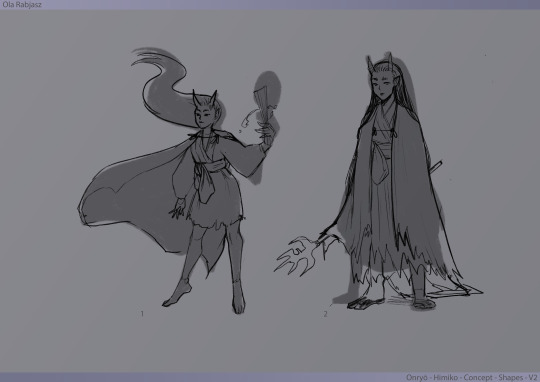
working on chosen shapes
Her journey to redemption proved challenging. Salvation, in her eyes, meant a final, tranquil death. Yet, she now traverses the lands, wielding ofuda strips around her arms to heal various diseases. However, the ultimate act of atonement requires a warrior capable of destroying a crystal embedded within her chest—a feat no one has accomplished thus far.

initial concept
Himiko's attire draws inspiration from the courtly fashion of Japanese Heian Era noblewomen, specifically the jūnihitoe. However, for ease of travel, she opts for a simplified ensemble consisting of the hitoe, kosode, and nagabakama. Her only accessory—a fan—serves as a form of self-defense in her 'human' form.
Abilities:
Skill 1 – 'Grant me salvation' allows Himiko to heal allies with ofuda, but attacking Himiko interrupts this ability. She can attach the ofuda to herself as well, but it heals her at a slower pace and she is slowed.
Skill 2 – 'Leave' employs her fan to create a forceful gust, pushing enemies away or stunning them against high terrain/walls.
Skill 3 – 'No running' erects a hair-based wall, providing tactical advantages for allies – said wall can be destroyed by enemies, attacked by allies – upon attacking the wall, allies are pulled towards the wall by hair – one allied attack takes ¼ hp of the wall. The wall counts as high terrain/wall, so if paired with S2, it can make for a nice combo. If not interacted with, the wall disappears after a short period.
Ultimate – 'FREE ME' transforms Himiko into her Onryō form, granting new abilities and altered health but ultimately returning to her human state afterward.

Himiko concept revisited after personal observations
Himiko's playstyle varies—able to function as either a mage or support character. In her mage built, she excels in potent abilities but with reduced survivability. Alternatively, as a support, her focus lies in crowd control and aiding allies, offering strategic synergy with AOE spells.
Ultimate skills:
U-S1 – "COME CLOSER" is a skillshot ability that, upon hitting an enemy, pulls them towards Himiko, causing damage in the process.
U-S2 – "LET ME TASTE YOU" involves a short-ranged attack where Himiko bites an enemy, dealing damage, applying a stack of bleeding effects (Damage Over Time), and slowing the target.
U-S3 – "HEAR ME, FEAR ME" involves Himiko emitting a piercing scream, generating a sound wave around her. Allies within the wave's range, along with Himiko herself, gain increased attack and movement speed. Enemies hit by the sound wave experience either: a) a slowed movement if their HP is above 50%, or b) a temporary state of fear if their HP is below 50%.
Clothing notes:
In the end, I decided to choose colour version number 2 from the picture below - despite Himiko’s beautiful appearance, this colouring indicates a sense of danger. The pattern on her hitoe is a simplified version of a spider lilly, a red flower associated with death. This also resonates with the view Himiko saw upon transforming - her first memory being the taste of flesh and blood and her husband’s dead body laying beneath her feet. White colour can also be associated with the dead, and Onryō are often depicted in white kimono.

colour selection based on the revised sketch
Personality
Personality-wise, Himiko remains aloof and self-serving. However, she occasionally displays a softer side, especially towards toddlers, pregnant women, and rodents—resonating with remnants of her human past. Uninterested in idle chatter, she views others as beneath her but occasionally indulges in harmless pranks for her own amusement. Despite her lack of need for sustenance, she occasionally enjoys the taste of well-brewed green tea or grilled fish.
As an undead entity, Himiko foregoes the need for sustenance or belongings. Unaffected by temperature, her attire serves a dual purpose: fashion and blending in with humans. Speaking in a formal manner, she keeps a deliberate distance from others, viewing them solely as a means to achieve her salvation.
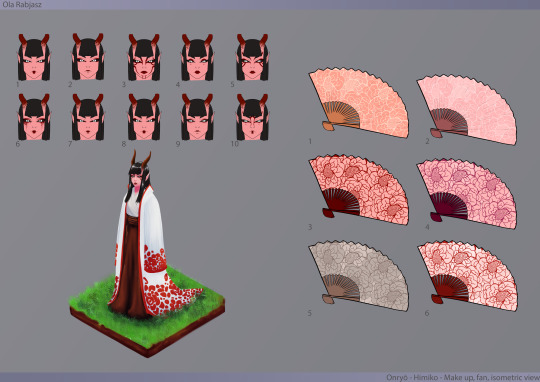
isometric view, make up and fan variations
Despite her demonic nature and self-centered demeanor, traces of her humanity persist—unknowingly preserved by the monk's intervention. Her salvation lies in acknowledging this buried humanity, an aspect she intensely denies, having spent an eternity detached from her human self.
Final notes
Himiko was very fun to work on - I got to use knowledge from my studies (Japanese culture) and creativity. I imagined her as a character in a MOBA-type game (League of Legends-like), hence lots of different abilities.
0 notes
Text
Aya's clothes
This will be one hell of a ride, but I really wanted to describe better how Aya's clothes work so you will understand how much she despises the attire she has to wear on formal days.
When she is using her Onmyoji attire, she is simply using a kariginu. That means underwear + sashinuki + the kariginu itself. She avoids the hat mostly because she is a filthy fucker who doesn't like it that much, but will use it on more special occasions. In theory, she shouldn't use this kind specifically, since they are more towards males, but since when does that even stop her?
However...her more important clothing is a nightmare for her, because it has. So. Many. Layers.
Jūnihitoe layers aka the clothes of a noblewoman:
Undergarments, tipically a two-piece cotton or silk garment.
Kosode: short white (could be red, but she prefers white) silk robe of ankle or lower calf length.
Nagabakama: basically a more formal hakama. A long af pleated red skirt, sewn with two split legs.
Hitoe: an unlined silk robe. Typically wears one red or blue-green, depends on the day.
Itsutsuginu: this is where hell begins. There are many layers of multicolored robes, or even uchigi. We are talking of many layers, like, possibly twelve in total (I'm a bit unsure if counting everything else or not). She hates it. She still has to wear it. At least she can shed some layers if it's too hot.
Uchiginu: scarlet beaten silk robe, works as support and a stiffener.
Uwagi: Patterned and decorated silk robe. Considering her status as a some sort of "middle-class" member of the Fujiwara clan, her clothes have very beautiful patterns.
Karaginu: waist-length Chinese style jacket.
Mo: Looks like a huge apron, worn trailing down the back of the robe. Usually white with a dyed or embroidered adornment
The end result is something similar to this, but with less makeup. She really, really hates the makeup, and no matter how much her family wants her to be a perfect little princess, she won't do it. Nope. And her hair isn't that long either, which is also something worth of note. Long hair was very desireable back at Heian Period.
#musings::aya#ONE DAY i will draw her clothes. this is not today#it was already a hassle to figure out everything she wears like holy shit
0 notes
Text
Interesting tidbits on the Kanou Eitoku “Scenes around Kyoto” painting. I specify Eitoku, because there’s multiple paintings referred to with the same name/title, done by different artists in different eras. Kanou Eitoku’s one is the one that’s era-appropriate. He made this by commission of the shogun Yoshiteru, but the shogun died before the job is done. Eitoku finished the painting anyway, and Nobu bought it(?) to send to Kenshin as a “please don’t invade me” present.
Worked for a while, but Kenshin still got pissed off anyway later on and Tedorigawa happened.
There’s a bunch of falconers here, with the ponytail. Not entirely sure what’s up with these falconers. They have horses, so they’re not peasants, but I don’t see any rank signifier.

At any rate, the common people seem to prefer ponytails as well. Like the regular people and peddlers and stuff. Same hairdo as above.
These are the folks I call “attendants”, because I see them wearing hats that are part of samurai formal wear, but their hakama are rolled up. They also seem to be doing menial work, like carrying objects or escorting palanquins on foot.

^ Curious if these are high-born vassals, or “middle tier” attendants that may come from humbler backgrounds. Because quite a while ago, I theorized that if these people don’t have to be high born vassals, then this can be a reasonable entry level job that Hideyoshi did for whatever reason.
Also, those short rolled-up hakama are not just a weird way of drawing hakama because the hakama worn correctly looks like this:

Possible proof that a Sengoku era nagabakama is long, but not as long as an Edo era one:

The fabric clearly goes longer than where his feet are, but it’s not that long. Also you can see the various pages and attendants carrying swords, but they all look like they only have one.
Also, some samurai vassals who are wearing their hair in the folded style, and not a ponytail:

So pages and middle-rank vassals wear ponytails, but higher-class vassals wear their hair folded? Maybe?
Also, there’s this boat being paraded for what looks like a festival in Gion. Note the flower crest decorating the drapery. The Yasaka-jinja of Gion has a crest that is identical to the Oda mokkou. It’s the symbol of Susanoo, actually.
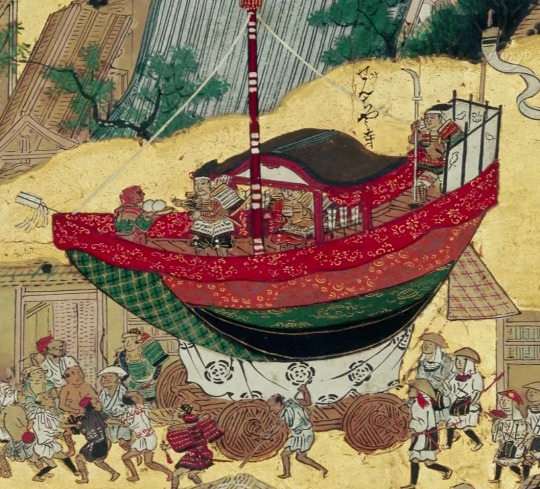
It’s kind of partially why I think that Nobu made the weird Dairokuten Maou claim partially as reference to Shinto lore. He seems to be somewhat conscious and/or careful about Shinto gods in his early-ish years. Then he eventually goes “Woops, I don’t care” later on.
5 notes
·
View notes
Photo

Long trousers (nagabakama) for kyōgen theater [from a set], Unknown Japanese, early 20th century, Minneapolis Institute of Art: Japanese and Korean Art
cloth trousers with straps that go over shoulders; sage-green at top of trousers that fades into an indigo color; white emblem at top flap of trousers, with stacked white liner hexagons throughout top green area; stylized origami birds and same scalloped design that is at the top flap are throughout the middle blue area; thin maroon straps attached at PR and PL outer leg area
Size: 55 7/8 × 23 1/2 in. (141.92 × 59.69 cm) (not including straps)
Medium: Cloth: hemp; katazome (stencil resist)
https://collections.artsmia.org/art/131681/
25 notes
·
View notes
Text
I’m feeling sickly rn so I won’t be replying to much but
For the people who’ve just followed recently... here’s an actual historical fact of smth Nobunaga did, as recorded in the Chronicle of Nobunaga, verbatim:
“Dōsan’s motivation [for visiting his son-in-law] was this: People in those days generally looked down upon Nobunaga; some even told Dōsan to his face that his son-in-law was a big idiot. Dōsan always responded that if this was what everybody was saying, then Nobunaga probably was not a fool at all. Now he evidently decided to go have a look and judge for himself.
...
In view of all the talk about Nobunaga’s lack of seriousness, Saitō Yamashiro [Dosan] devised a plan to take him by surprise and make a laughing stock of him. He arrayed some seven or eight hundred senior retainers, all of them ceremoniously dressed in stiff sleeveless robes and formal trousers, on the verandah of the main hall of the Shōtokuji in such a way that Kazusa no Suke would have to pass in front of them. But first Yamashiro Dōsan hid in a hut on the edge of town to spy on Lord Nobunaga’s arrival.
This was Nobunaga’s get-up that day: He had his hair straight up like a tea whisk, tied with fresh-green ribbons, and wore a bathrobe with its sleeves removed. He bore a great sword and a dagger, both with gold-encrusted sheaths, stuck into a straw rope that he had wrapped around himself, and a thick bracelet made of hemp secured his sword to his wrist. From his waist dangled seven or eight gourds and pouches for flints, as though he were some kind of monkey-trainer. His half trousers were made of four panels of tiger and leopard skin, each dyed a different color. He came accompanied by seven or eight hundred men in close formation, his crack troops marching in front.
...
As soon as he arrived at the temple where he was to lodge, he had folding screens put up around him and:
[1] for the first time in his life had his hair done decently, gathered at the back and doubled over the top part of the head in the oriwage style;
[2] donned long formal trousers (nagabakama) of a dark blue color, although nobody knew when he had had them dyed;
[3] girded on a small sword, also commissioned in advance without anyone’s knowing.
When his retainers saw Nobunaga in this attire, they realized to their bewilderment that lately he had been playing the fool on purpose. One after the other, they paid their compliments to him and made their apologies.
Nobunaga proceeded toward the main hall with an easy stride. As he ascended the verandah, [his retainers] rushed to him, asking him to come quickly.
Ignoring them, Nobunaga with a nonchalant air slid by smoothly in front of all the samurai lined up on the verandah and then sat down against a pillar. After a while, a pair of screens was pushed back and Dōsan emerged. Nobunaga, however, remained seated with a totally unconcerned air. When Hotta Dōkū came up to him, saying, “This is Lord Yamashiro [Dosan],” Nobunaga merely remarked, “Is that so?”
He then crossed the threshold, went inside, greeted Dōsan, and took his place without further ado in the sitting room.”
TLDR: Nobunaga’s father-in-law wanted to see if Nobunaga was as much of an idiot as everyone was saying. They agreed to meet up at a shrine, but Dosan spied on Nobunaga before he got to the shrine and saw him dressing like a fool, only for Nobunaga to change into formal clothes at the shrine and throw everyone off.
Also, saying “is that so?” when his powerful father-in-law was introduced to him, like a smarmy teen.
Extra:
“[After this event, on Dosan’s way home,] [his retainer] said to him, “Regardless of anything I have seen today, I still think that Kazusa no Suke [Nobunaga] is a fool.” But Dōsan merely replied, “If you are right, then that is really too bad. Because I fear that one day my children will have to tie their horses to the gate of this fool.”
From that moment on, nobody ever called Nobunaga a fool again in Dōsan’s presence.”
#( treasury - saved )#( the chronicle - headcanon )#[i just needed to put that here in full]#sengoku jidai#oda nobunaga
3 notes
·
View notes
Photo

Fun fact: the Steel Samurai here isn’t wearing hakama - those are much closer to nagabakama, which are similar to hakama, except longer and meant to be stepped on and trail behind, as these do. Interestingly, they were typically a female piece of clothing, but you sometimes see male courtiers or bodyguards wearing them in paintings in the Edo period.
I thought this was interesting, as it gives at least a further indication of the Steel Samurai’s social class and what era of Japan Neo Olde Tokyo is potentially based on in regards to the Olde part. So, you know, now you know and can do with this information what you will. I am by no means an expert on these subjects, so if I’m missing or misinterpreting details, please, feel free to add on to this!
46 notes
·
View notes
Text
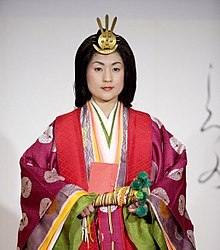


The jūnihitoe (十二単) - lit. "the twelve layers" - was the style of formal court dress worn by ladies-in-waiting at the Japanese Imperial Court in the Heian period. The jūnihitoe, despite the name, varied in its exact number of layers, and was composed of several different kimono-style garments.
The jūnihitoe first appeared some time around the 10th century; however, by the Kamakura period, the number of layers worn by artistocratic ladies, even in court, had been reduced heavily. In the present day, the jūnihitoe is still worn by members of the Imperial House of Japan on important occasions.
The layers of clothing may be known by separate names, such as hitoe (unlined robe), itsutsuginu (五衣) which is a series of robes (usually 5 and of different colours), a short coat karaginu (唐衣), and mo (裳). The last three terms can be combined to give the formal name for the jūnihitoe set of clothing – itsutsuginu-karaginu-mo (五衣唐衣裳). The layers of the jūnihitoe consist of:
The undergarments: Usually a two-piece cotton or silk garment.
Kosode: A short silk red or white robe of ankle or lower calf length.
Nagabakama: The formal version of hakama worn by noble women; it is a very long red pleated split skirt.
Hitoe: An unlined silk robe; usually red, white or blue-green, although other colors (such as dark red-violet or dark green) very rarely occur.
Itsutsuginu: A series of brightly coloured robes or uchigi, usually 5 or sometimes 6, which create a layered effect. Many more layers of uchigi were worn during the Heian period until the government enacted sumptuary laws reducing the number of layers worn.
Uchiginu: A beaten scarlet silk robe worn as a stiffener and support for the outer robes.
Uwagi: A patterned woven and decorated silk robe than is shorter and narrower than the Uchiginu. The colour and fabric used for the uwagi indicate the rank of the wearer.
Karaginu: A waist length Chinese style jacket."Mo": An apron-like train, down the back of the robe. White with painted/embroidered adornment.
Today, the jūnihitoe can only normally be seen in museums, movies, costume demonstrations, tourist attractions or at certain festivals. These robes are one of the most expensive items of Japanese clothing. Only the Imperial Household still officially uses them at some important functions. Women such as an empress or princess wear a jūnihitoe, while men such as the Emperor or a prince wear a sokutai. During the wedding of Empress Masako to the crown prince, she wore a jūnihitoe for the official ceremony. The jūnihitoe was also worn by Empress Michiko during the enthronement ceremony of Emperor Akihito in 1990. Her ladies-in-waiting were all wearing the jūnihitoe; however, in modified form from the Edo period, not the Heian style.
0 notes
Text
Reflections on the 38th Annual Kyogen Performance
#nohgaku #kyogen [asijnews.com]Tuesday, March 8 marked our 38th annual Kyogen performances. Kyogen, with its nagabakama (extra-long pants), archaic language and smooth movements, has a 650-year history of comedy, relating stories that are accessible to all of us regardless of our ...
0 notes
Text


Samurai's ranks and dress code in Late Edo period
AMAZING reference chart put together by Nadeshico Rin, showing the different attires worn by the men of the buke class in and about Edo Castle. OP stresses the chart is by no means exhaustive - but it helps picturing things SO MUCH!
For easier reading, I have adapted the chart with english translation. Rin has also created illustrations detailing each attire, I'll translate those in coming days under the tag "samurai kimono".
You'll find the transliteration below cut:
The court ranks - Mibun 身分 or Ikai (位階)
Find more about the exact titles here.
一位 Ichii (First court rank)
三位 Sanmi (Third court rank) and 四位 Shii (Fourth court rank)
Goi 五位 (Fifth court rank)
Omemie ijô 御目見 以上, the "upper" vassals allowed to request audience with the shogun
Omemie ika 御目見 以下, the "lesser" vassals (not allowed to request audience with the shogun)
Rin does not mention the second court rank (二位 Nii) so I am not sure where this one is supposed to go ^^;
The clan/families - Kamei 家名
徳川将軍家 Tokugawa shôgunke (Tokugawa Shogun clan)
尾張徳川家 Owari Tokugawake (Owari Tokugawa clan), 紀伊徳川家 Kii Tokugawake (Kii Tokugawa clan), 水戸徳川家 Mito Tokugawake (Mito Tokugawa clan), 徳川御三卿 Tokugawa gosankyo (Secondary Tokugawa branch clans: Tayasu, Shimizu, and Hitotsubashi)
三奉行 Sanbugyô, & 下三奉行 Shimosan bugyô (magistrates, governors)
旗本 Hatamoto (general term for upper-rank vassals of the Tokugawa)
御家人 Gokenin (general term for lower-rank vassals of the Tokugawa)
Outfits TPO (Time, Place, Occasion)
第一礼服 (大礼 など) Daiichi raifuku (tairei nado) - Most formal outfit worn during State/important ceremonies, etc.
礼服 (正月など) Raifuku (Shogatsu nado) - Formal outfit, worn for events like New Year, etc.
通常礼服 (節句など) Tsûjô raifuku (sekku nado) - Regular
formal outfit, worn during seasonal festivals, etc.
平服 Heifuku - Everyday outfit
Type of outfits
Rin has released separated charts detailing the different costumes. You'll find them translated here in coming days.
束帯 Sokutai - old ceremonial court dress, first worn by Heian nobility. Attire includes the 笏 shaku (flat ritual sceptre), and 冠 kanmuri hat.
衣冠 Ikan - old ceremonial court dress, much more simpler than sokutai
布衣 Hoi - "plain" 狩衣 kariginu (which were informal clothes worn by the nobility from the Heian period and onwards)
素襖 Suô - ceremonial dress of the lower-ranked samurai
直垂 Hitatare - ceremonial court robe
狩衣 Kariginu - patterned kariginu (informal clothes worn by the nobility from the Heian period and onwards)
大紋 Daimon - 直垂 hitatare with large family crests
直衣 Nôshi - everyday robes which were first worn by males of the imperial family during Heian era, and then spread among nobility, etc.
長上下 Naga Kamishimo - outfit pairing a sleeveless ceremonial robe called 肩衣 kataginu, with trailing pants called 長袴 nagabakama
半上下 Han Kamishimo - outfit pairing a sleeveless ceremonial robe called 肩衣 kataginu, with ankle lenght pants called 半袴 hanbakama
#japan#history#fashion history#samurai kimono#samurai#nadeshico rin#edo era#edo period#shogun#tokugawa#ressources#references#Sokutai#Ikan#Hoi#Suo#Hitatare#Kariginu#Daimon#Noshi#Kamishimo#nagakamishimo#hankamishimo#kataginu#hakama#nagabakama#hanbakama#court rank#buke#warrior class
752 notes
·
View notes
Text
Reflections on the 39th Annual Kyogen Performance
#nohgaku #kyogen [asijnews.com]Tuesday, March 8 marked our 39th annual Kyogen performances. Kyogen, with its nagabakama (extra-long pants), archaic language and smooth movements, has a 650-year history of comedy, relating stories that are accessible to all of us regardless of our …
0 notes
Photo

The Actor Bando Mitsugoro II in Ceremonial Robes with Kamishimo (via The Metropolitan Museum of Art)
See how he has his hands inside him nagabakama? This is a way to walk when wearing this garment, by pulling it up to keep from tripping.
7 notes
·
View notes
Text
Priests' outfits - Jikitotsu, Daimon, and Hentetsu
(as worn during Edo period - great charts by Nadeshico Rin). You can find more about samurai ranks and their regulated attires under the tag "samurai kimono".
"Hight Priest" jikitotsu
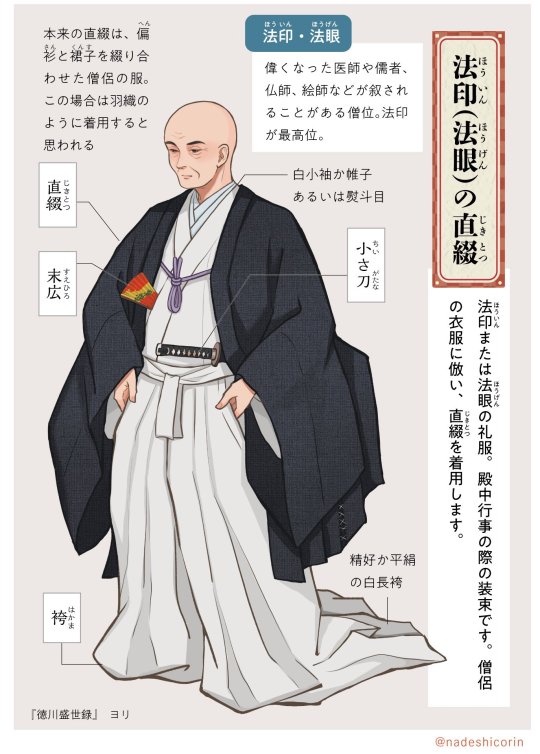
This outfit was worn for court events by Buddhist priests of the highest rank ( 法印 Hôin) and second highest rank (法眼 Hôgen). Those titles could also be also given to 儒者 Confucian scholars, 医師doctors, Buddhist 絵師 painters and 仏師 sculptors, etc.
直綴 Jikitotsu - type of monk robe, originally made by stitching together a 偏衫 henzan (monk robe covering the upper body) and a 裙子 kunsu (monk robe covering the lower body) together.
Overtime, jikitotsu came to be worn opened, more like a haori vest.
末広 Suehiro - a type of formal folding fan. TN: the fan drawn here ressemble more a 中啓 chûkei, as suehiro have curving ribs which don't seems to be the case here (find more about fan types here)
(長)袴 (Naga)bakama - hakama pants with long trailing legs, here made of hiraginu (plain silk)
白小袖 Shiro-Kosode - white kosode (=ancestor of the kimono)
/or/ 帷子 Katabira - thin garment made from hemp or raw silk (worn during Summer). Note that 経帷子 kyôkatabira designates a shroud (=the white kimono used to dress the dead).
/or/ 熨斗目Noshime - kosode (=ancestor of the kimono) with stripes/lattice pattern at waist area
小さ刀 Chîsagatana - small katana
"Companion" formal kimono
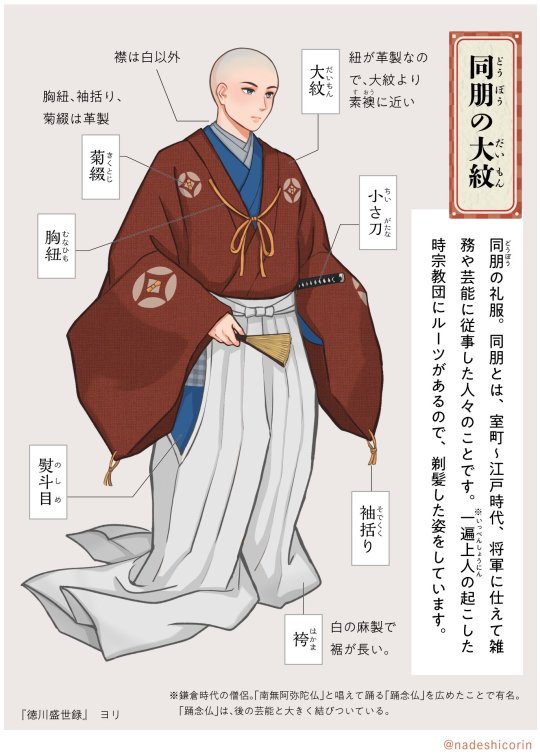
First people helping buddhist priests, 同朋 dôbô (lit. "companions) became overtime men attending on the Shogun, feudal lords and other high-ranked officals.
They were in charge of miscellaneous tasks (like cleaning, messengers etc.), or depending on their talents more skilled ones (dance, music, ikebana, tea ceremony etc.).
大紋 Daimon is a specific hitatare set, patterned with large 紋 mon (clan/family crests)
菊綴 Kikutoji - decorative tassel-like knots, first appeared on Heian nobility clothes. Here, those were leather ones
胸紐 Munahimo - chest ties, first appeared on Heian nobility clothes. Here, those were leather ones
熨斗目 Noshime - kosode (=ancestor of the kimono) with stripes or lattice pattern at waist area.
Also note the colored undergarments collars.
袖括 Sodekukuri - decorative sleeve ties. Originally appeared on Heian clothings (like kariginu, nôshi, etc) where they were used to tighten sleeve cuffs. Here, those were leather ones
(長)袴 (Naga)bakama - hakama pants with long trailing legs, here made of white linen
小さ刀 Chîsagatana - small katana
The Proto-haori

This outfit was the formal wear worn by lower class priests, scholars, doctors, artists, etc.
編綴 Hentetsu (lit. "stitched together") - a vest with large and long boxy sleeves, made from gauze or plain silk, most often black or dark brown. The chest straps were also made of the same fabric
It evolved from 十徳 jittoku (itself a variation of 直綴 jikitotsu, see above). First a casual wear for court nobles, and then spread to lower-class samurai who wore it over their kosode from Muromachi era and on.
Its use then reached other social classes during Edo period. Overtime and minor variations, it finally became known as our modern 羽織 haori
服紗(小袖) Fukusa(kosode) - a kosode (=ancestor of the kimono) bearing crest, and made from soft silk (like habutae or rinzu). In summer, it was a katabira (thin garment made from hemp or raw silk)
/or/ 熨斗目 Noshime - kosode (=ancestor of the kimono) with stripes or lattice pattern at waist area
#japan#history#fashion#samurai kimono#nadeshico rin#samurai#edo era#edo period#ressources#references#men kimono#着物#buddhist priest#monk#jikitotsu#henzan#kunsu#Suehiro#chûkei#nagabakama#kosode#Katabira#Noshime#Chîsagatana#dôbô#Daimon#Kikutoji#munahimo#Sodekukuri#Hentetsu
189 notes
·
View notes
Text
Everyday wear for the warrior class - Nagakamishimo and Hankamishimo
(as worn by samurai of the Edo period - great charts by Nadeshico Rin). You can find more about samurai ranks and their regulated attires under the tag "samurai kimono".
The Nagakamishimo (here with noshime)
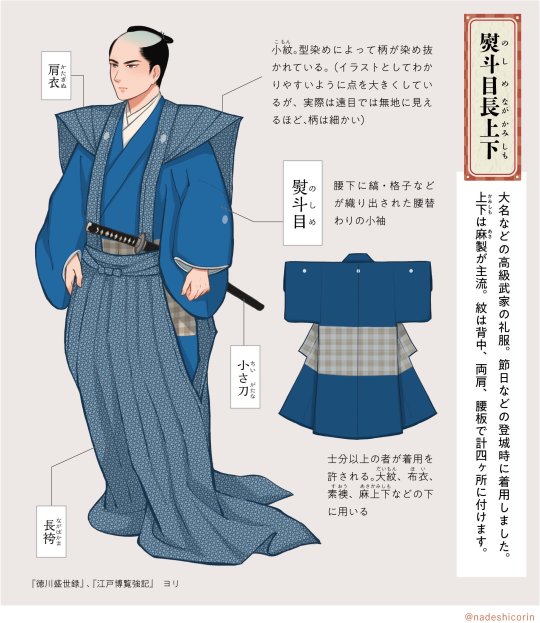
長上下 Nagakamishimo was worn by all upper ranked samurai.
肩衣 Kataginu - sleeveless overvest, with startched shoulders. It bore back and shoulder 紋 mon (family crests).
It's said to be an evolution of 素襖 Suô attire with detached sleeves.
Formal ones were also entirely covered with tiny dyed patterns, the 小紋 komon (clans tended to have their favourite ones, used by all their retainers).
長袴 Nagabakama - hakama pants with long trailing legs.
Formal look required it to match the kataginu.
熨斗目 Noshime - kosode (=ancestor of the kimono) with stripes or lattice pattern at waist area. Note the mon family crest on the sleeves and back.
Noshime was also worn under more formal sets, like the daimon, suô, hoi, etc.
小さ刀 Chîsagatana - small katana
The Hankamishimo

Also called 継上下 tsugi-gamishimo, 半上下 hankamishimo is the official everyday wear for all Edo period samurai.
Main difference with nagakamishimo are the shorter pants, far more suited to everyday life. Colors and fabrics were not especially regulated.
半袴 Hanbakama - ankle lenght pants, shorter than the more formal nagabakama. Today, it's simply called hakama.
脇差 Wakizashi - short sword worn by samurai, depending on the era is part of the 大小 daishô (sword set with a katana and wakizashi)
紋付小袖 Montsuki-kosode - kosode (=ancestor of the kimono) adorned with family crest
#japan#fashion#fashion history#samurai fashion#nadeshico rin#edo period#samurai#buke#warrior class#edo era#reference#ressources#men kimono#着物#Nagakamishimo#Hankamishimo#kataginu#nagabakama#noshime#Chîsagatana#hanbakama#wakizashi#daishô#Montsuki-kosode#kosode
174 notes
·
View notes